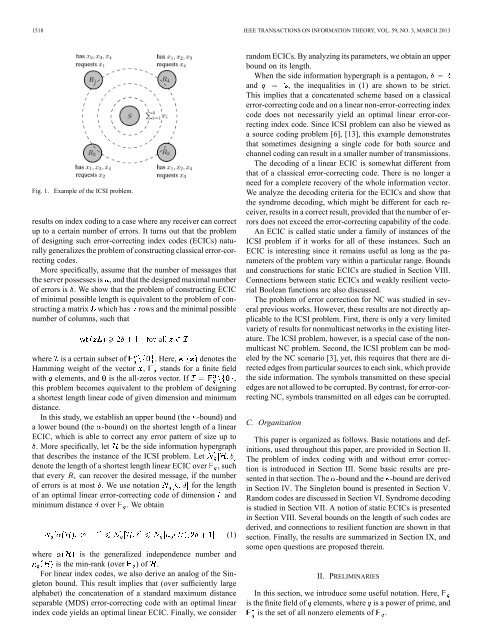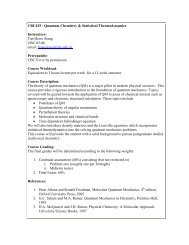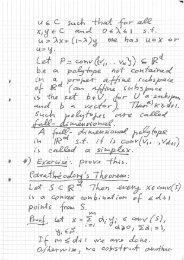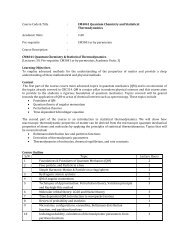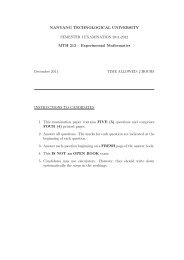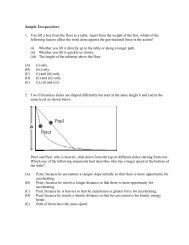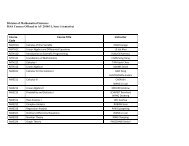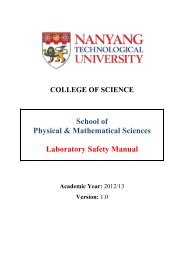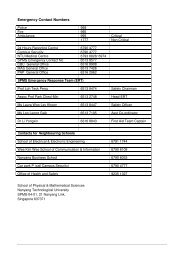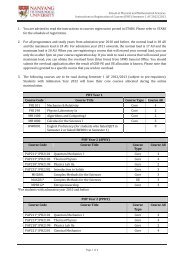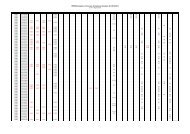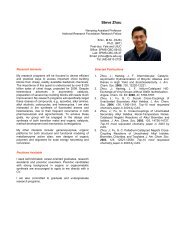Error Correction for Index Coding With Side Information - Spms
Error Correction for Index Coding With Side Information - Spms
Error Correction for Index Coding With Side Information - Spms
You also want an ePaper? Increase the reach of your titles
YUMPU automatically turns print PDFs into web optimized ePapers that Google loves.
1518 IEEE TRANSACTIONS ON INFORMATION THEORY, VOL. 59, NO. 3, MARCH 2013Fig. 1.Example of the ICSI problem.results on index coding to a case where any receiver can correctup to a certain number of errors. It turns out that the problemof designing such error-correcting index codes (ECICs) naturallygeneralizes the problem of constructing classical error-correctingcodes.More specifically, assume that the number of messages thatthe server possesses is , and that the designed maximal numberof errors is . We show that the problem of constructing ECICof minimal possible length is equivalent to the problem of constructinga matrix which has rows and the minimal possiblenumber of columns, such thatwhere is a certain subset of . Here, denotes theHamming weight of the vector , stands <strong>for</strong> a finite fieldwith elements, and is the all-zeros vector. If ,this problem becomes equivalent to the problem of designinga shortest length linear code of given dimension and minimumdistance.In this study, we establish an upper bound (the -bound) anda lower bound (the -bound) on the shortest length of a linearECIC, which is able to correct any error pattern of size up to. More specifically, let be the side in<strong>for</strong>mation hypergraphthat describes the instance of the ICSI problem. Letdenote the length of a shortest length linear ECIC over ,suchthat every can recover the desired message, if the numberof errors is at most .Weusenotation <strong>for</strong> the lengthof an optimal linear error-correcting code of dimension andminimum distance over .Weobtainwhere is the generalized independence number andis the min-rank (over )of .For linear index codes, we also derive an analog of the Singletonbound. This result implies that (over sufficiently largealphabet) the concatenation of a standard maximum distanceseparable (MDS) error-correcting code with an optimal linearindex code yields an optimal linear ECIC. Finally, we consider(1)random ECICs. By analyzing its parameters, we obtain an upperbound on its length.When the side in<strong>for</strong>mation hypergraph is a pentagon,and , the inequalities in (1) are shown to be strict.This implies that a concatenated scheme based on a classicalerror-correcting code and on a linear non-error-correcting indexcode does not necessarily yield an optimal linear error-correctingindex code. Since ICSI problem can also be viewed asa source coding problem [6], [13], this example demonstratesthat sometimes designing a single code <strong>for</strong> both source andchannel coding can result in a smaller number of transmissions.The decoding of a linear ECIC is somewhat different fromthat of a classical error-correcting code. There is no longer aneed <strong>for</strong> a complete recovery of the whole in<strong>for</strong>mation vector.We analyze the decoding criteria <strong>for</strong> the ECICs and show thatthe syndrome decoding, which might be different <strong>for</strong> each receiver,results in a correct result, provided that the number of errorsdoes not exceed the error-correcting capability of the code.An ECIC is called static under a family of instances of theICSI problem if it works <strong>for</strong> all of these instances. Such anECIC is interesting since it remains useful as long as the parametersof the problem vary within a particular range. Boundsand constructions <strong>for</strong> static ECICs are studied in Section VIII.Connections between static ECICs and weakly resilient vectorialBoolean functions are also discussed.The problem of error correction <strong>for</strong> NC was studied in severalprevious works. However, these results are not directly applicableto the ICSI problem. First, there is only a very limitedvariety of results <strong>for</strong> nonmulticast networks in the existing literature.The ICSI problem, however, is a special case of the nonmulticastNC problem. Second, the ICSI problem can be modeledby the NC scenario [3], yet, this requires that there are directededges from particular sources to each sink, which providethe side in<strong>for</strong>mation. The symbols transmitted on these specialedges are not allowed to be corrupted. By contrast, <strong>for</strong> error-correctingNC, symbols transmitted on all edges can be corrupted.C. OrganizationThis paper is organized as follows. Basic notations and definitions,used throughout this paper, are provided in Section II.The problem of index coding with and without error correctionis introduced in Section III. Some basic results are presentedin that section. The -bound and the -bound are derivedin Section IV. The Singleton bound is presented in Section V.Random codes are discussed in Section VI. Syndrome decodingis studied in Section VII. A notion of static ECICs is presentedin Section VIII. Several bounds on the length of such codes arederived, and connections to resilient function are shown in thatsection. Finally, the results are summarized in Section IX, andsome open questions are proposed therein.II. PRELIMINARIESIn this section, we introduce some useful notation. Here,is the finite field of elements, where is a power of prime, andis the set of all nonzero elements of .


